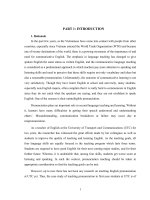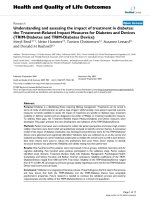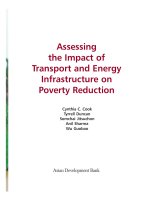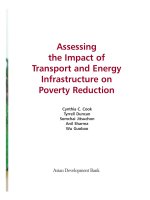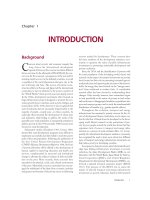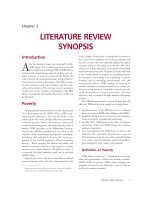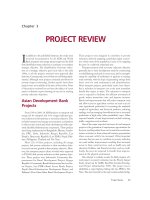Assessing the Impact of Transport and Energy Infrastructure on Poverty Reduction - Chapter 1 docx
Bạn đang xem bản rút gọn của tài liệu. Xem và tải ngay bản đầy đủ của tài liệu tại đây (255.17 KB, 6 trang )
Introduction 1
Chapter 1
INTRODUCTION
Background
C
oncern about poverty and economic inequity has
long driven the international development
agenda. However, this concern has taken different
forms over time. In the aftermath of World War II, the con-
cern was for the economic consequences of the war and for
ensuring rapid recovery in the defeated countries, to avoid
a repetition of the social phenomena that gave rise to the
war in Europe and Asia. The success of postwar recon-
struction efforts in Europe and Japan led the international
community to turn its attention to the poorer countries of
the Third World, where poverty was more deeply rooted.
In the 1960s, development investments often focused on
large infrastructure projects designed to promote the eco-
nomic growth of poor countries, such as ports, bridges, and
power plants. In the 1970s, however, it was recognized that
such investments did not necessarily bring benefits to the
majority of peoplemostly poorin those countries. In
particular, they promoted the development of urban areas
and industries, while failing to address the needs of the
generally poor rural population. Consequently, attempts to
address poverty in the 1970s and early 1980s became more
focused on rural development.
Subsequent studies (Chambers 1983; Cernea 1985)
showed that rural development programs were difficult to
implement successfully and often failed to reach the poorer
parts of the rural population. Following the publication of
the first United Nations Development Programme
(UNDP) Human Development Report in 1990, the focus
of poverty alleviation efforts shifted to the development of
human capital by improving education and health care
services, complemented by structural and institutional
change to alleviate the indirect burdens of debt and infla-
tion on the poor. More recently, these concerns have
extended to the physical, social, and cultural environment
of the poor. Meanwhile, resource constraints have encour-
aged the withdrawal of the State from economic activities
and greater involvement of the private sector in delivering
services needed for development. These concerns have
led some members of the development assistance com-
munity to question the value of public infrastructure
investments in promoting sustainable development and
poverty reduction.
Since the 1970s and the identification of poverty with
the rural population of the developing world, theory and
research on the impact of transport investments on poverty
have focused on their role in promoting increased agricul-
tural production and improving the incomes of farm house-
holds. In energy, they have focused on the energy transi-
tion from traditional to modern fuels. A considerable
research effort has been devoted to understanding these
changes. Only recently, however, have researchers begun
to look specifically at the nature of poverty in both urban
and rural areas, to disaggregate beneficiary populations into
poor and nonpoor groups, and to study the intrahousehold
distribution of benefits (e.g., gender-specific effects).
Throughout this evolution, transport and energy
infrastructure has remained a priority concern for the cli-
ents of development finance institutions, and a major con-
duit for the flow of funds from the developed to the devel-
oping world. Recent research on the perceptions of pov-
erty by poor people around the world also shows that they
experience lack of access to transport and energy infra-
structure as a process of social exclusion (Box 1.1). Conse-
quently, the international development assistance community
has recognized the need to learn more about how different
types of transport and energy infrastructure investments can
help reduce poverty in developing countries.
In response to shared concerns about the limited knowl-
edge base linking infrastructure investment to poverty
reduction, the Asian Development Bank (ADB), in col-
laboration with the World Bank, Japan Bank for Interna-
tional Cooperation (JBIC), and United Kingdoms
Department for International Development (DFID), un-
dertook a regional technical assistance project (RETA
5947). The purpose of this RETA was to assess the
impact of selected transport and energy infrastructure
investments on poverty reduction, based on field research
2 Assessing the Impact of Transport and Energy Infrastructure on Poverty Reduction
in three Asian countries. Its objectives were to enhance
current understanding of how transport and energy infra-
structure and services contribute to poverty reduction, to
fill knowledge gaps, and to identify lessons learned and
good practices to be taken into account in future develop-
ment assistance operations. The RETA was also intended
to help formulate the infrastructure components of
national or regional poverty reduction strategies in ADBs
developing member countries (DMCs). Finally, it aimed
to help build capacity in DMC research institutions to
design and conduct policy-relevant research on poverty
and infrastructure.
Methodology
The scope of work for the study was set forth in an
ADB technical assistance paper, approved in October
2000 (ADB 2000a). A Steering Committee for the study
was set up, involving representatives of the four develop-
ment partner institutions, as well as key decision makers
and interested staff from ADB. In Stage 1, an interna-
tional consultant team consisting of a poverty specialist, a
transport specialist, and an energy specialist, supported
by an ADB research assistant, and in consultation with
staff of the four collaborating institutions, conducted a
review of relevant literature and project experience, to
identify knowledge gaps and prepare proposals for field
research. In Stage 2, teams from domestic research insti-
tutions undertook field work and data analysis in three
ADB DMCs. The three teams came together at the
beginning and end of Stage 2 in technical workshops, held
in the participating countries, to coordinate the study meth-
odology and to share the field work findings across the
three countries. In Stage 3, the results of the three country
studies were compared to identify new knowledge gained
and the policy and operational implications to be drawn
from it, as well as priorities for future research.
Before starting the study, the consultant team identi-
fied some key issues.
The impact of any physical investment on poverty is
highly dependent on the policy context. Thus, the study
needed to take into account variations in policy context
as well as actual infrastructure investment. These varia-
tions include both macroeconomic and social policy, as
well as sector policy issues.
The impact of infrastructure investment on poverty is
mediated by the provision of efficient, reliable services
to the poor. Thus, the study should consider not only
improvements in infrastructure but also in transport and/
or energy services, as well as the targeting of such ser-
vices to the poor.
Box 1.1. Perceptions of the Poor about Transport and Energy
Many poor communities are isolated by distance, bad road conditions, lack of or broken bridges, and inadequate transport. In
both rural and urban areas, these conditions make it difficult for people to get their goods to market and themselves to places of
work, to handle health emergencies, to send children to schools, to obtain public services, and to keep in touch with events and
influence decisions.
A community without roads does not have a way out.
A poor man, Juncal, Ecuador
If we get the road we would get everything else, community center, employment, post
office, water, telephones.
A young woman, Little Bay, Jamaica
Energy scarcity emerges as especially acute for poor people in the urban areas of the cold-weather climates of Eastern Europe
and Central Asia As in so many domains, so with energy scarcity: the poor and vulnerable suffer, and finally the children.
Finding firewood for cooking is the problem. Very soon we may have to go to the town to
buy firewood.
A woman, Viyalagoda, Sri Lanka
Gas heating is a great joy for us.
A poor elderly man, Takhtakupyr, Uzbekistan
Source: Narayan et al. 2000. pp. 7580.
Introduction 3
Improvements at the margin of an infrastructure net-
work can have a positive impact on the poor only if the
network itself functions well. Thus, if access to ser-
vices by the poor has already been provided, improve-
ments in the cost-effectiveness of service provision on
the network as a whole may have a greater poverty
impact than additional infrastructure investment.
Transport and energy investments meet different but
complementary needs for the poor. In some circum-
stances, a substitution effect may apply (e.g., informa-
tion flow); at other times, synergy may occur (e.g., elec-
tricity for schools and clinics can enhance the effec-
tiveness of services provided via improved road
access). In still other ways, their effects may be entirely
separate. Similarly, the contributions of transport and
energy investments to poverty reduction are likely to
be different in urban and rural areas.
Literature and Project Review
The study team identified research on the impact of
transportation and energy infrastructure on poverty
reduction through a search of bibliographic databases. It
searched the Econ Lit database (in a CD-ROM from
ADBs Library), containing reports and articles from vari-
ous economic journals, for relevant studies. The World
Bank website, mainly the infrastructure and poverty sec-
tions, also yielded substantive results. The staff of ADBs
divisions responsible for transport and energy operations
provided suggestions on addi-
tional studies that could be use-
ful for the RETA. In addition,
the study coordinator and sec-
tor specialists on the interna-
tional study team identified rel-
evant publications. DFID and
JBIC representatives on the
Steering Committee also made
suggestions, as well as the
RETAs peer reviewers and
participants in review work-
shops. The results of the review
reported in the RETA Interim
Report (ADB 2001a) were
updated after the field work was
completed in 2003.
The study team also carried
out a review of ADB transport
and energy projects between
1993 and 2000 that indicated
poverty as a primary or secondary objective, and of World
Bank poverty-oriented transport and energy projects
approved between 1994 and 2000. The objective of the
review was to identify the technical approaches used and
expected outcomes for poverty reduction, with particular
attention to any plans for monitoring poverty impacts and
any relevant evaluation results. The study team reviewed
project summaries and appraisals for these projects,
together with selected projects carried out by DFID and
JBIC.
The findings of the literature review are summarized
briefly in Chapter 2 and more fully in the Appendix. A
complete list of the studies reviewed is given in the Bibli-
ography. The findings of the project review are reported in
Chapter 3. The literature and project review helped iden-
tify the research hypotheses and to evaluate the available
evidence concerning the impacts of transport and energy
infrastructure investments on poverty reduction in devel-
oping countries. This information formed the basis for a
knowledge gap analysis and the formulation of proposals
for the field research, described in Chapter 4.
Country Case Studies
During Stage 1, suitable countries and regions within
countries, as well as qualified domestic research institutions
in those countries, were identified, with the approval of
the RETA Steering Committee. Proposed country team
leaders participated in the review workshop on the RETA
A truck transports crops to market in Jamnagar, in Indias Gujarat State.
4 Assessing the Impact of Transport and Energy Infrastructure on Poverty Reduction
Interim Report, held in November 2001. The research
institutions were then invited to submit proposals in which
they would identify the specific transport and energy
investments to be studied and the research hypotheses they
believed to be most appropriate for pursuing the policy
dialogue in their countries. They were also asked to con-
stitute national steering committees and to plan for
national workshops in which the findings of their country
studies could be discussed and disseminated. These pro-
posals formed the basis for a Study Methodology Work-
shop held in Bangkok, Thailand, in January 2002.
The three country teams examined the full range of
research hypotheses identified in Stage 1, regarding rural
transport and energy improvements (generally, rural roads
and rural electrification). They gave less attention to urban
transport and energy investments, although the Thailand
team did carry out urban case studies. Apart from rural
road improvements, the teams variously looked at rail, port,
and major road improvements. All three country studies
used a combination of quantitative and qualitative meth-
ods, and performed secondary data analysis for the pur-
pose of selecting sample communities and households, as
well as for comparison to the results of field surveys. Each
team collected data from community-level key informants
as well as from selected sample households. Community
discussions and group interviews also yielded data. The
three teams shared preliminary results in a workshop held
in Vadodara, Gujarat State, India, in July 2003. National
seminars were also held in all three countries between April
and October 2003.
Comparative Analysis
and Conclusions
A RETA draft final report was reviewed in a workshop
held at ADB in Manila in October 2003. Based on this
review, the RETA Steering Committee concluded that
additional analysis was needed to further explore the
results of the country studies and to further develop the
policy and operational implications of the research. This
work was completed by April 2004 and is reflected in this
final report. Chapters 14 summarize the current state of
knowledge about transport and energy investments and
their impacts on poverty. Chapters 57 describe the coun-
try contexts and case studies. Chapters 810 present the
findings of the RETA, its policy and operational implica-
tions, and priorities for future research. Data sources are
detailed in the Bibliography.
Introduction 5
6 Assessing the Impact of Transport and Energy Infrastructure on Poverty Reduction
Transport and energy enable other activities to bring about poverty reduction. Policies and
approaches to operations should seek to realize the full potential of this enabling influence.

